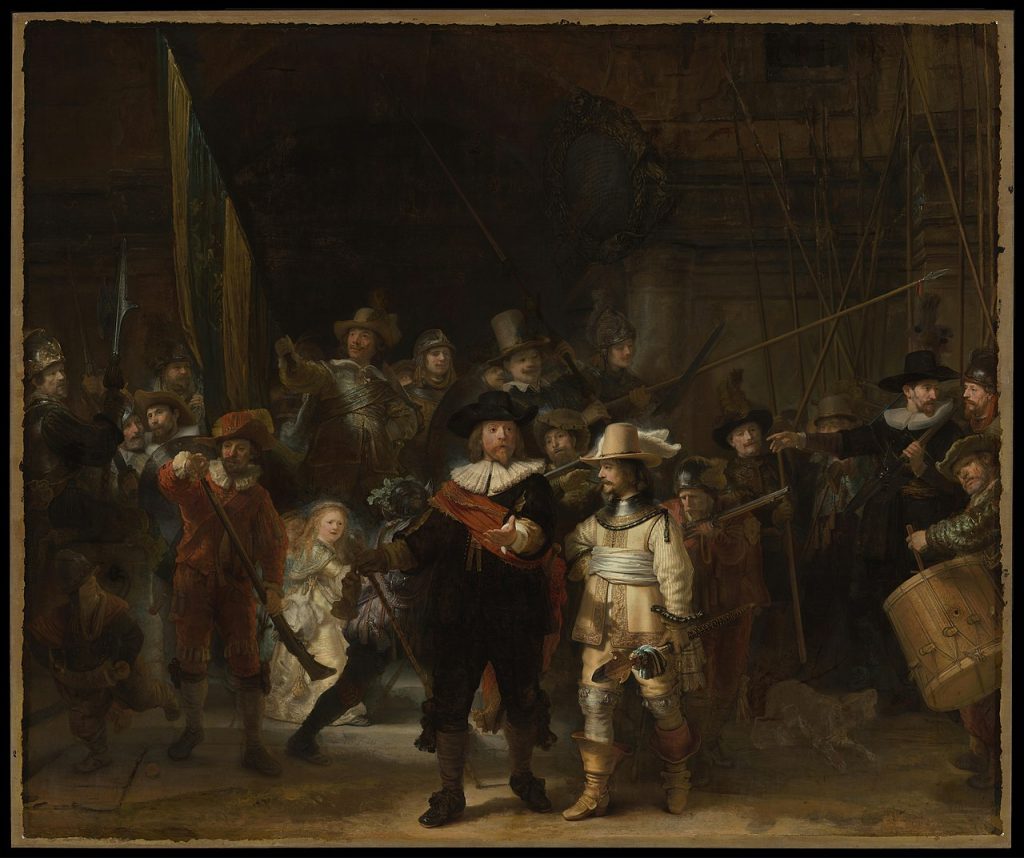Pratiksha Shome
Rembrandt van Rijn’s 1642 painting, The Night Watch, depicts the Militia Company of District II under the Command of Captain Frans Banninck Cocq, also known as The Shooting Company of Frans Banninck Cocq and Willem van Ruytenburch. Although it is the most well-known painting in the Rijksmuseum’s collection, it is actually in the Amsterdam Museum’s collection and is prominently shown there. One of the most well-known Dutch Golden Age paintings is The Night Watch.
1. The Time of the Night Watch is not at night.
Over the following century, the title Night Watch surpassed the lengthy monikers for the artwork in terms of popularity. Rembrandt’s work, however, was created during the day. The background that seemed like the night sky was actually a varnish that had become dark with time and grime. The varnish was taken off during a restoration in the 1940s, but the name persisted.
2. might have a cameo of Rembrandt.
In the midst of this bustling group of notable men, you can make out a scarcely visible individual hiding behind a man in green and a guard with a metal headgear. Only his eye and a beret are visible, but Rembrandt is thought to have inserted himself into this enigmatic figure in order to create his most well-known painting.
3. That young blonde girl is a mascot, not from the military.
This supposedly lost moppet is armed with a klover gun and a chicken with noticeable claws. Both were emblems of the guild that purchased the artwork for their meeting room, the Kloveniers, the city guard of Amsterdam.
4. The Night Watch broke with the custom of the military portrait.
Numerous officers, colonels, and cadets had their pictures painted in static poses. Rembrandt deviated from tradition by portraying his soldiers as if they were in motion.
5. Rembrandt was not paid his commission as agreed.
Following the completion of The Night Watch, Rembrandt began a ten-year stretch during which he drastically reduced the amount of paintings he produced and stopped creating portraits. It has long been believed that the guild members who were obligated to pay for these pictures felt underappreciated and refused to contribute their full amount, harming Rembrandt’s reputation in the process. However, more recent scholarship suggests that the Kloveniers were content with the unusual artwork and hung it in the hall. How did Rembrandt get over the Night Watch blues? He might have just felt that he had overstepped the boundaries of his craft and wanted to start over.
6. It’s larger than you’d anticipate.
The Night Watch, Rembrandt’s most well-known work, was also his largest, measuring almost 12 feet by 14 feet.
7. The painting comes with a caption key of its own.
The Night Watch was moved to the town hall and dressed for the event long after Rembrandt had passed away. However, this wasn’t his piece’s only unapproved change. An unidentified person embellished the archway with a shield, which bears the 18 names of the featured Kloveniers in writing.
8. Three attacks against the Night Watch have taken place.
A homeless navy cook allegedly cut The Night Watch on January 13, 1911, as a form of protest against his unemployment. On September 14, 1975, a Dutch schoolteacher who believed destroying it was his holy purpose carried out a second stabbing. The picture was thereafter kept under constant watch. On April 6, 1990, a jobless Dutchman nevertheless splashed strong sulfuric acid on the object. Each time, restorations were successful in repairing the harm, leaving almost any signs of the war.
9. The alternative titles are substantially more detailed and lengthy.
There are several, including the District II of Amsterdam Officers and Other Civic Guardsmen, under the leadership of Captain Frans Banninck Cocq and Lieutenant Willem van Ruytenburch; the District II Militia Company; and the Frans Banninck Cocq and Willem van Ruytenburch Shooting Company. The important thing was that Cocq (in a red sash) and Ruytenburch (in yellow next to Cocq) received attention, regardless of the variations in the details. However, it comes as no surprise that the moniker The Night Watch became popular.
10. It has long served as the focal point of one of the largest galleries in the world.
Construction of the Rijksmuseum in Amsterdam began in 1885 with a focus on displaying Rembrandt’s enormous masterpiece. A decade-long renovation of the museum took place about 120 years later. Director Wim Pijbes triumphantly proclaimed, “Everything has changed, the only thing that hasn’t changed is The Night Watch,” as he got ready for the museum’s reopening in 2013. The entire Rijksmuseum is built around this magnificent work of art, which serves as its altarpiece.
11. Reconstruction started in 2019.
A $3.4 million repair project on The Night Watch started in July 2019 and is anticipated to take a year to complete. To assure accuracy throughout the endeavour, tens of thousands of high-resolution images and laser scans of the painting will be taken. However, the painting will still be accessible to the public, and visitors can observe restoration efforts from behind glass.
Also read: 11 Things You Didn’t Know About Rembrandt van Rijn
Also read: Rembrandt, 350 years after the Dutch Golden Age






